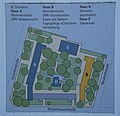Clara Zetkin Home
The “Clara Zetkin” care and senior citizens' home is located in the Johannstadt district of Dresden , between Neubertstrasse, Pfotenhauerstrasse and Fetscherstrasse, directly west of the Carl Gustav Carus University Hospital . The nursing home , named after the socialist peace activist and women's rights activist Clara Zetkin since 1950 , was called the Städtisches Bürgerheim until 1945 .
Citizens' Home
On October 1, 1856, the Dresden Council decided to use the proceeds of the Güntz 'Foundation according to the foundation deed to build a community hospital. Around 1864, a municipal community hospital was founded in Dresden-Friedrichstadt . Primarily intended for medical care for the elderly, the facility was relocated to Pfotenhauerstrasse 86 to 88 in Johannstadt around 1890. This non-profit retirement and nursing home was open to "poor elderly citizens of at least fifty years of age and an innocent reputation" . For a certain amount of money, needy citizens could enter the company. In return, those affected received lifelong care, free living and medical care. The new building began around 1890 and the inauguration took place in 1894. On June 15, the first 200 residents moved into the new facility, and the Dresdeners affectionately call them beneficiaries . In 1894 a chapel was built in the park of the community center.
Extension of the community center
After the First World War , necessary extensions were made. The necessary new buildings were built from 1925 to 1926 on the land on Neubertstrasse and what was then Fürstenstrasse (today Fetscherstrasse) acquired by Mayor Bernhard Blüher . Thanks to very generous interest-free building loans and donations from surpluses of the Güntz Foundation in 1923, the building measures could be financed and implemented. According to plans by the Dresden city architect Paul Wolf , a clinker brick building with two wings was built with a representative view on Fürstenstrasse. A clinker brick walkway connects the east wing and the west wing, together with the chapel in the middle of the park.
Clara Zetkin Nursing and Retirement Home
As a result of the devastating air raids on Dresden from February to April 1945, considerable parts of the community center were totally destroyed (north wing) or severely damaged. After the rubble had been cleared and the first makeshift repair of the usable building wings, no care for the elderly took place. Due to the great housing shortage, bombed out and displaced persons were initially accommodated. City institutions later found accommodation in the building complex. The partially destroyed buildings were rebuilt under very difficult conditions. On October 7, 1950, the nursing home and retirement home was reopened under a new name as the Clara Zetkin home . The totally destroyed north wing was only cleared of rubble. In the years 1971 to 1974, after a long planning period, the north wing and a farm building were built in prefabricated construction. From 2009 to 2010 the north wing was converted into a multi-generation house with around 150 apartments.
today
The entire complex of the Clara-Zetkin-Heim consists of the now listed side wing from around 1926 with the additional additions from 1894 on Fetscherstrasse and the north wing on Pfotenhauerstrasse 86 to 88 as well as the farm building from 1974.
The Clara Zetkin nursing and retirement home is operated by the German Red Cross District Association Dresden e. V.
Inside the building complex there is a beautifully designed park with trees that are over 100 years old and the former chapel, today used for geronto-psychiatric day care. The Knabenbrunnen has been in the park since 1941, made for the 1936 Reich Garden Show by the Dresden sculptor Gustav Reissmann , and a life-size bronze figure.
In August 2010, a memorial plaque was put up on Fetscherstraße to commemorate and commemorate the founder Justus Friedrich Güntz .
The modernized nursing and retirement home Clara Zetkin offers 170 single and 38 double rooms, up to 250 people in need of care can be cared for.
literature
- Karl Simmang, Paul Hünig, Walter Haase u. a .: Association of Saxon master carpenters Dresden: The community home. Folder A. 48 panels including colored drafts of dining, men's, living rooms and bedrooms as well as kitchens; Verlag Friedrich Max Gutewort, Dresden; 1925.
- The extension of the community center on Fürstenstrasse. In: Dresdner Anzeiger , 1926. 109, p. 3.
- Matthias Lerm : Farewell to old Dresden: Loss of historical building stock after 1945. Hinstorff-Verlag Rostock: 1st edition 2000, ISBN 3-356-00876-5 , p. 51 (area rubble Johannstadt-Nord).
- Fritz Löffler : The old Dresden: history of its buildings. ISBN 3-86502-000-3 , p. 432.
Web links
- DRK nursing and senior citizens' home "Clara Zetkin"
- Bürgerheim in Pfotenhauerstraße on altesdresden.de
- Pfotenhauerstraße, Bürgerhospital on Dresdner-Stadtteile.de
Individual evidence
- ↑ Wolf, Paul . In: Hans Vollmer (Hrsg.): General lexicon of fine artists from antiquity to the present . Founded by Ulrich Thieme and Felix Becker . tape 36 : Wilhelmy-Zyzywi . EA Seemann, Leipzig 1947, p. 215 .
Coordinates: 51 ° 3 ′ 27.3 " N , 13 ° 46 ′ 33" E








